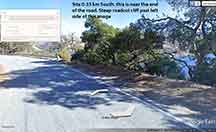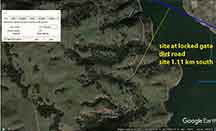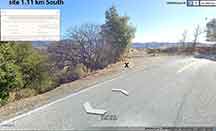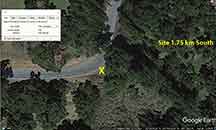




============================================================================================================================
You'll see in the Schedule of Classes as an on-line course. However, I've proposed that Astro be allowed to conduct this class as a real out-in-the-field Field Astronomy course, with safety provisions for the CoVid situation. I don't know yet if that will be approved, but if you're seeing this page, I'll be updating it as new information is settled.
If the class continues as an on-line class, the best model for how this would be conducted is my recently concluded Astro 25 Summer '20 course which I hope you'll look at. It consisted of Zoom sessions with recordings then available asynchronously, and grading to be accomplished through a 47 multiple choice question final exam do-able "take home" style but on Canvas, with a week long unlock period to work on the exam. Answers can be found in my Zoom recordings, and of course you can Google for answers as well, or use the prior nominal textbook "The Cosmic Perspective" by Bennett et al if you have it, or you could buy an old edition for cheap on Amazon.
If the class can be transformed back to a real field class, I would still plan to go to the Stanislaus River. The date of the weekend would be Apr 16-18, 2021; Friday through Sunday noon. In that case, we'd follow much of the information shown below (except the pre-trip meeting would not be on-campus but instead be on-Zoom). You'd find your way to our proposed campground used on the prior 2017 Fall Astro 25 trip. You'd be camping in your own tents, I'd be responsible for all group meals (meal fee of $10 to be collected at the campsite) except lunches and snacks, so you could more easily stay socially distant and not touch the food preparation. Food would be cooked of course. Mask up when in the presence of others, of course. We may or may not be able to get into the California Caverns but even if not, there's a creek which tunnels through limestone (Natural Bridge natural area) which is very interesting and has many of the formations seen in California Caverns, and a great place to enjoy cool water on a hot end-of-summer day. I'd have my usual micro-lectures on the trails as we hike to this spot (just a 2-3 mile hike round trip), and there's the Stanislaus River itself we can enjoy right at camp. I hope that we'll have volunteer telescope operators as in the past. For sure you'd have yours truely with Cabrillo Observatory equipment!
I will continue to update this course, prefaced by a date like this first entry Nov 19, 2020. Check back regularly, and when I have enrollment, I'll email you as well.
Jan 27, 2021
My NAS Dean has just asked me to take a poll of the class, if you're "willing to take the class as a field trip" (instead of just on-line). So there's a possibility we can do this as a real field trip. Here's the additional safety issues I had to promise to enforce if we do a real field trip. Please take them seriously and then I will, in Canvas, ask you to respond to me on whether you will take this class only if it's strictly on-line, or whether you can and would take it as a real field trip. Here's the safety requirements
* No carpooling with others except if they already are partners or room mates
* No group meals; you'd need to bring your own food and preparations (camp stove, etc)
* Masks in all group situations
* 6ft apart as we hike to places
* Sleep in your own tent or if shared, only with your already room mates or partners.
So, that would mean I can't cook my famous French Crepes meal. However, I'm going to ask again about that since I should get the vaccine sometime "soon", as I expect being a 68 year old teacher will move me up in the priorities. If I'm "safe", I'd expect perhaps the meals I prepare would be safe too. But again, I'll have to ask about that later after I've gotten my 2 vaccine shots.
The Dean says it would have to be unanimous. In other words, if there are students who don't feel it would be safe and will only take the class if it is on-line, then it must remain on-line and not a field trip class.
The location of the field trip is also a bit uncertain. It depends on whether and also if the U.S. Forest Service campground (Sourgrass campground) will be open. I very well might not. If not, my back up plan is to conduct the class at Carrizo Plain National Monument, which allows open disbursed camping in the Caliente Mountains.
Apr 14, 2021 - Lunar Graze Plans
I'm still planning on getting video footage of the lunar grazing occultation which is the astronomical centerpiece of this class. However, the campgrounds all along the graze path are closed and I will not be making a trip to Stanislaus River. Instead, I'll be putting together a slide show from past trips there, and presenting that to you at a later time, after the weekend is over and I've had a chance to assemble it.
As for the graze, the path also goes closer to home, across Calavaras Reservoir. Weather is expected to be good this Saturday night and I also have a chance to have a couple of other helpers who (like me) have had their CoVid vaccine shots, and who are experienced amateur astronomers with loaner equipment from me to get data on the graze. I'll let you know how it goes as soon as I return from the graze, but again it will be a bit more time to assemble something to show you.
Here's the map showing the graze path, and locations which are expected to see the star disappear and reappear several times during the few minutes of the graze, as the star passes behind the dark side mountains and valleys on the edge of the 29% sunlit evening cresent moon.
Apr 15, 2021 - Our first Zoom lecture (recording is here).
We covered the evolution of stars, how low mass, medium mass, and high mass stars follow different evolutionary paths towards their final resting place. We'll have a quiz (asynchronous, on Canvas) soon, after I prepare it. It'll be a straight multiple choice quiz with maybe 10 questions. You'll have plenty of time to get it done. Here is the PDF of the powerpoint, so you can review that as well as listen on Zoom. I don't know about you, but when I try to play back these Zoom recordings they are glacially slow and spend most of their time getting a few bytes of information before playing for a second or two, then repeat. Very frustrating. I'll orient my questions so just by reviewing the PDF of the PowerPoint you should be able to access all the answers. I'll have another lecture Zoom soon. Stay tuned. I'm also still working on getting the video I recorded during the graze ready for viewing.
Our Lunar Grazing Occultation - a few images for you.
 |
 |
 |
 |
 |
Site 1.11 km south.
 |
 |
Site 1.75 km south
 |
 |
Site 2.75 km south
First site we'll arrive at. Barely possible wide spot in the road. I hope whomever is here can pull off enough to be safe.
 |
 |
I met the rest of my team at the top of Hwy 17, at Summit Rd, and we strategized and I began shooting some video for Astro 25. Karl von Ahnen was my long time lab assistant at Cabrillo until he got a great job running the planetarium at De Anza College for many years. Kirk Bender is a former student, and long time programmer and astronomy worker. We'd take 3 different positions to see the star graze slightly different tracks along the tangent to the moon. It was tough finding "stations"; I spend many hours studying the graze profile and Google Earth looking for good places that would be safely off the narrow road through the hills above the reservoir, and also promise as many contacts with the moon's mountains we could get.
We first came to Kirk's station; too little shoulder space, we settled on the second site I'd found; with still good prospects for multiple mountains. Then my site. Just enough space to get off the road (tilted albeit). Then to Karl's, where we set to recording more video while I showed him how to set up the 8SE telescope and electronics. It would be tight on time; the telescope requires 2 alignment stars and the sky would not be dark enough to see any alignment stars until just 50 minutes before the graze. We hit a snag at that point - no images on the Camcorder LCD screen. We traced it to no power to the Watec camera. I checked the fuse inside the male 12VDC plug. It was blown. Lucky I had spare fuses and got it fixed, and then got Karl's scope ready to go. No time to really instruct fully; I'd counted on the PDF of the PowerPoint I'd posted on how to set up and operate this equipment. A few last second tips as I rushed to get to my car and drive the mile back to my own stations, a wide spot at a turn, at 1.75 km south of the limit line. I've got lots of practice getting this rig going quickly, and was more or less ready to record by 10 minutes before the graze started. I only wish I'd had time to
|
fisheye lens view of my station, amid the oak trees |
See the YouTube video our our lunar grazing occultation! That was the highlight around which this trip was designed.
Because of the awkward nature of this Spring's field class, I am altering my grading. More is required in the form of Canvas quizzes, but the grading scale is made more generous. Instead of the grading scale you see on the main Astro 25 course page. , instead I will use the grading scale below, from averaging your quizzes.
Grade Scale
80% for an A
70% for a B
60% for a C or "pass"
50% for a D
The rest of our materials; quizzes, PDF's of PowerPoint, are found on Canvas.
The Student Learner Outcomes, and other formalities are found on the main Astro 25 course page.
Our YouTube lectures done in the field are linked soon.
===========================================================================================================================
This field astronomy course will keep us busy both staring upward at the universe, and staring deep underground at the amazing geologic processes happening in limestone caverns. With the recent discovery of possible running water and also limestone formations on Mars, the processes we'll study here may happen more widely on other planets.
Here's a link to the formation of Caverns. and some recent work using them for studying paleo climate change. We camped near here and explored the caverns as part of Astro 28X back in Spring '08. Check out the photos from that adventure. Farther up Hwy 4 back in '01 for Astro 28E; before I was so meticulous about digital photo-recording everything. However, check out the pix I did get at the link. We also went here just last year, in 2017, and had a great adventure. See the pictures here.
In the Rock Shop, ready for the descent |